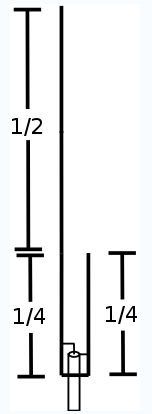
As you can see the aerial is in 3 main parts. The main conductor is 3/4 wave length, the 1/4 wave main stub and the bridge. No balun is required as the resistance can be matched to feed into 50 Ohms coax.
The making of my J-Pole
If you look at the diagram of my aerial, then you will see that in fact it is very easy to build. I used normal copper heating pipe. You would need about 2 and a half meters of 1/2" copper heating pipe, 2x T-pieces to fit and an SO-239 chassis mounted coax socket.

The measurements are taken from the centre of the pipes. From 'A1' to 'A' is 149cm. The stub from 'B1' to 'B' is 49cm. The bridge 'C' is 46mm (4.6cm). On the stub you drill a 6mm hole, at 'Y' which after assembly would be looking towards the main reflector, this is measured from the middle of the bridge up to 'Y' at 5cm. Before soldering the coax socket onto the assembly at 'X' then you should solder a insulated wire from the socket of about 75cm in length. thread the wire up through the 6mm drill hole and solder the socket onto the T-Piece. After soldiering all the assembly together then peel off the insulation from the end of the wire and using a rust-free water hose clip connect to the main reflector, about 50mm from centre of bridge at 'Y2'. The SWR should be better than 1.1:1 at 145MHz.You can adjust the clip for lowest SWR. If you can't adjust the SWR then solder a brass nut into the end of 'A1' and 'B1' and screw a long brass screw into the nut. This way you can lengthen or shorten the stub and reflector. To attach to mast you can use 3 to 4 car type water hose clips below point 'A'. I have tested my antenna over 10 years with, up to 450Watt and have had no problems.
Back to the Ham page Back home